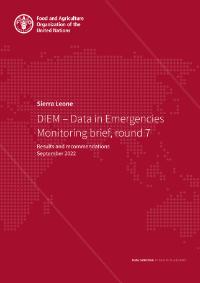Publications

Enhancing nutrition in emergency and resilience agriculture responses to prevent child wasting: FAO's child wasting prevention action plan (2023–2024)
11/2022
As part of the United Nations Global Action Plan on Child Wasting, FAO requires USD 500 million to implement its action plan to prevent child wasting (2023–2024) in the 15 most-affected countries.

Colombia: DIEM – Data in Emergencies Monitoring brief, round 3
11/2022
This Data in Emergencies Monitoring (DIEM-Monitoring) brief shares the results of a third-round assessment conducted between July and August 2022 in Colombia.

Mali: DIEM – données en situations d’urgence, bulletin cycle 4
11/2022
Ce bulletin sur le suivi Données dans les situations d'urgence (DIEM-Suivi) présente les résultats de la quatrième évaluation réalisée entre juillet et septembre 2022 au Mali.

Somalia Famine Prevention Scale-up Plan: May 2022 – June 2023
11/2022
FAO’s scaled-up Famine Prevention Plan seeks to reach extremely vulnerable rural communities in areas at high risk of famine to avert further catastrophe and stem the rapidly rising numbers of persons displaced due to the prolonged drought. Deaths due to hunger, malnutrition and related diseases are on the rise.

Pakistan: Belgium’s contribution through the Special Fund for Emergency and Rehabilitation Activities (SFERA)
11/2022
The lives and livelihoods of around 3.3 million people in Pakistan, mostly living in rural areas, have been significantly disrupted by this year’s massive monsoon driven floods.

Myanmar: Response overview (October 2022)
11/2022
Humanitarian needs in Myanmar continue to rise sharply since February 2021 as a result of political and economic upheaval and increased conflict.

Zimbabwe: DIEM – Data in Emergencies Monitoring brief, round 5
11/2022
This Data in Emergencies Monitoring (DIEM-Monitoring) brief shares the results of a fifth-round assessment conducted in September 2022 in Zimbabwe.

Afghanistan: DIEM – Data in Emergencies Monitoring brief, round 5
11/2022
This Data in Emergencies Monitoring (DIEM-Monitoring) brief shares the results of a fifth-round assessment conducted between July and August 2022 in Afghanistan.

Niger: DIEM – données en situations d’urgence, bulletin cycle 4
10/2022
Ce bulletin sur le suivi des données dans les situations d'urgence (DIEM-suivi) présente les résultats de la quatrième évaluation réalisée en juillet et août 2022 au Niger.
.jpg?sfvrsn=bfb57cad_11)
South Sudan: DIEM – Data in Emergencies Monitoring brief, round 3
10/2022
This Data in Emergencies Monitoring (DIEM-Monitoring) brief shares the results of a third-round field assessment conducted between May and July 2022 in South Sudan.

Haiti: Response overview
10/2022
In Haiti, sociopolitical unrest, economic decline, violence perpetrated by armed groups, low agricultural production, rising food and fuel prices, and frequent natural disasters have led to increased levels of food insecurity.

Ukraine: Humanitarian response update, 18 October 2022
10/2022
This document provides an up-to-date summary of the humanitarian situation in Ukraine and the response of the Food and Agriculture Organization of the United Nations (FAO) on the ground.

Contribution from the Government of Sweden to FAO: Annual report 2021
10/2022
In 2021, the Government of Sweden, through the Swedish International Development Cooperation Agency (Sida), contributed SEK 94 million (USD 11.08 million) to the Food and Agriculture Organization of the United Nations (FAO) emergency and resilience programme.

Lebanon: DIEM – Data in Emergencies Monitoring brief, round 3
10/2022
This Data in Emergencies Monitoring (DIEM-Monitoring) brief shares the results of a third-round field assessment conducted between July and August 2022 in Lebanon.

Iraq: DIEM – Data in Emergencies Monitoring brief, round 7
10/2022
This Data in Emergencies Monitoring (DIEM-Monitoring) brief shares the results of a seventh-round field assessment conducted between March and May 2022 in Iraq.

Cash transfers
10/2022
Generic information about FAO's cash transfers (conditional cash transfers and unconditional cash transfers)

Mozambique: DIEM – Data in Emergencies Monitoring brief, round 3
09/2022
This Data in Emergencies Monitoring (DIEM-Monitoring) brief shares the results of a third-round field assessment conducted between April and May 2022 in Mozambique.

Sierra Leone: DIEM – Data in Emergencies Monitoring brief, round 7
09/2022
This Data in Emergencies Monitoring (DIEM-Monitoring) brief shares the results of a seventh-round field assessment conducted between June and July 2022 in Sierra Leone.

République démocratique du Congo: DIEM – données en situations d’urgence, bulletin cycle 3
09/2022
Ce bulletin sur le suivi des données dans les situations d'urgence (DIEM-suivi) présente les résultats de la troisième évaluation sur le terrain réalisée entre avril et mai 2022 en République démocratique du Congo.

Ethiopia – Tigray: Belgium's contribution through the Special Fund for Emergency and Rehabilitation Activities (SFERA)
09/2022
Through the Special Fund for Emergency and Rehabilitation Activities, the Government of the Kingdom of Belgium is supporting FAO's efforts to ensure the timely provision of fertilizers to meet the input needs of farmers in Tigray, Ethiopia.
